#tascal
Explore tagged Tumblr posts
Text

Mexico City’s Tlecān Reimagines Tascalate — A Maya Drink made with Maíz, Cacao, Achiote and Water—as a bright and earthy mezcal cocktail. Photo: Andrew Reiner
An Ancient Drink Enters The 21st Century
— February 05, 2024 | By Ximena N. Beltran Quan Kiu
Tlecān, a minuscule mezcalería in Mexico City’s Roma neighborhood, is named after the Náhuatl word meaning “place of fire,” and it lives up to its name the moment you step inside.
A reddish-brown glow illuminates the space; smoke swirls under the dark and moody lighting. The air is thick and smells of an earthy resin. Along the back wall stands a replica of the disc of death, an iconic Aztec sculpture depicting Mictlantecuhtli, the god of death. It’s one of the bar’s many tributes to pre-Hispanic Mexican culture.
“Everything is designed so that whoever is Mexican feels proud to be Mexican, and whoever isn’t is impressed and wants to be Mexican,” says Eli Martinez Bello, co-owner of the bar. The bartender led the beverage program at Pujol, a revered culinary destination, for five years before transitioning to her current role.
Tlecān specializes in mezcal, offering 13 options from small-batch makers across the country who do not export their products outside of Mexico. At the bar, you can order any of the spirits neat, or enjoy them in a number of cocktails that take inspiration from centuries-old, pre-Hispanic drinks like tascalate.
Tascalate is more than 3,000 years old and originates from the southernmost Mexican state of Chiapas. It played a role in the ancient Maya city-state of Palenque, where greeting the king involved bowing, then drinking a full cup of tascalate as a sign of gratitude; leaving behind any liquid was considered disrespectful. Today, the drink is still primarily found in Chiapas.
“It’s a very simple and basic refreshment,” says Bernardo Serna, a partner of the mezcalería, “but that’s exactly why tascalate has lasted so long. Long before refrigeration began, people ground maíz, achiote and cacao into powder and preserved it. They survived winters by consuming this highly nourishing liquid.”

The drink itself is simple, made of pulverized toasted dry maíz (or corn), cacao and achiote (small, red, kernel-like seeds), blended with water—its name comes from the Náhuatl words “tlaxcalli” (tortilla) and “atl” (water). The maíz lends the drink a thick texture and mineral taste, while cacao brings bitter and sweet notes followed by the subtle heat of achiote. Everything is toasted before being ground down into a fine powder. Water is then carefully added to bring the tascalate to life.
At Tlecān, the drink follows a similar basic format. “We could have made these ingredients in-house at Tlecān, but instead we want to support local artisans whenever we can, so we purchase these handmade products in Chiapas,” adds Serna. In Chiapas, depending on the season, the drink is served piping hot or ice-cold and it’s now sometimes made with milk. But at the Mexico City bar, where it takes the form of a sour, it’s always chilled and made with water.
“Tlecān uses the tascalate to pay homage to all maíz drinks such as atole, tejate and champurrado—thick, cereal-like beverages that get their density from one of the oldest food ingredients in Mexican culture: maíz,” says Serna. The bar team found that tascalate’s unique texture was best suited to the sour template, made here with a base of mezcal complemented by egg white, agave nectar and lemon. “We use small-batch suppliers, so it’s possible the mezcal in the drink can change due to availability,” says Serna, “but the cocktail will always use a mezcal that’s earthy and a little acidic to bring out the flavor notes of the tascalate.”
The end result is a brick red cocktail topped off with a thick egg white foam. Despite its bold color, the Tascalate Sour tastes light, bright and earthy. It’s served in a coupe and finished with a dusting of fermented cacao powder.
“We’re working to tell the story of many generations of Mexicans and the history behind some of these traditional beverages,” says Martinez Bello, who serves her drinks alongside a modest food menu of street food staples, like the pambacito, a take on pambazo, a chunky bread roll dipped in salsa and stuffed with chorizo, mashed potatoes and Chihuahua cheese. Other cocktail highlights include the Todas Las Flores, a take on tepache that’s prepared with guanábana (soursop) and lavender; the Pulque Colada, where pulque, a boozy fermented brew made from agave sap and referred to as “the drink of the Gods,” arrives fresh from the Mexican state of Hidalgo and serves as the base; and the Ocelóyotl, which incorporates Veracruz’s traditional carajillo, a sweet coffee drink, in its build.
On Instagram, Tlecān has nearly 25,000 followers, but it follows only four accounts—all cultural institutions. It’s a nod to the bar’s design, which is made to mimic a museum gallery; the Aztec statue replicates one at Mexico’s Museo Nacional de Antropología. It’s the bar’s way of saying, “If you love us, go learn more about us, our culture,” says Serna.
For the bar team, Tlecān is a sacred space to pay tribute to pre-Hispanic traditions through gourmet drinks and dishes that are emblematic of Mexico. It’s an invitation for guests, Mexican and non-Mexican alike, to delve into the extensive history and rich culture of the country.
“I got into mixology to tell stories,” Martinez Bello adds. “Then I realized, there’s so much that’s already happened, things we can’t forget. So rather than inventing new [stories], I made this about going deep into Mexico’s history and culture, and bringing it to people here and now through drinks.”
— Elizabeth Quan Kiu V. helped translate and fact-check this piece. She is a Spanish-language journalist, translator and educator. Born and raised in Mexico City, Elizabeth immigrated to Chicago in the 1990s. She’s fluent in English and resides in Albuquerque, New Mexico.
#Source: PunchDrink.Com#Tlecān Reimagines Tascalate#Maya Drink#Maíz Cacao Achiote and Water 💧#Ximena N. Beltran Quan Kiu#An Ancient Drink 🥤 🍺 🍹
0 notes
Text




CAFÉ & CHOCOLATE FEST en el Palacio de la Autonomía de la Fundación UNAM, Centro Histórico, CDMX, los días 14 y 15 de Junio de 2025.
El evento ideal para festejar el “Día del Padre”.
**LA ENTRADA Y TODAS LAS ACTIVIDADES SON GRATUITAS.
Una parte de la utilidad neta de este festival, será destinada al fondo para el Programa de Becas de la Fundación UNAM.
Participa sin costo en Ceremonias de Cacao, Catas de Café, Talleres Sensoriales, Conferencias y Cuenta Cuentos para niños. Este es el evento ideal para festejar el “Día del Padre”.
El CAFÉ & CHOCOLATE FEST celebra la pasión y dedicación de productores artesanales del Centro y Sureste de México.
Desde el cuidado de las plantas de café y la siembra de las semillas de cacao, hasta la creación de sus productos, estos artesanos transmiten su talento y tradición a miles de visitantes en cada edición de esta magnífica feria gastronómica y cultural.
Los días Sábado 14 y Domingo 15 de Junio el CAFÉ & CHOCOLATE FEST llegará nuevamente al PALACIO DE LA AUTONOMÍA DE LA FUNDACIÓN UNAM, ubicado en Lic. Primo de Verdad No. 2, casi esquina con Moneda, en el Centro Histórico de la Ciudad de México, a solo dos cuadras del Zócalo y justo a la salida del Templo Mayor.
Podrás conocer a MÁS DE 60 EXPOSITORES y descubrir la historia cultural detrás de cada producto, disfrutando los sabores y aromas del café, cacao y chocolate en todas sus formas.
¡Un evento ideal para compartir en familia y celebrar a papá, en un ambiente divertido y saludable!
Prueba diferentes marcas de café de especialidad y escoge el que mas te agrade, ya que llegará café de regiones cafetaleras de Veracruz, Chiapas, Puebla, Oaxaca, Guerrero y Tabasco, entre otras, y de países invitados como Colombia y Turquía, disponible en grano o molido, con diferentes niveles de tueste.
También encontrarás exquisitos chocolates con alto porcentaje de cacao, desde las clásicas barras para preparar la bebida fría ó caliente, trufas y enjambres con semillas y frutos secos, hasta tabletas prehispánicas con chapulines y gusanos de maguey, así como una impresionante variedad de bombonería decorada con creatividad y rellenos exóticos. Además, podrás explorar degustando lo que se te antoje, teniendo a la mano una amplia gama de productos artesanales como miel, quesos, pan, mole, salsas, mermeladas, postres y dulces. Para refrescarte, no pueden faltar las bebidas tradicionales como la espuma de cacao, pozol, tascalate y agua de barranca. Las Actividades Culturales Gratuitas juegan un papel muy importante en este festival.
¿Te gustaría compartir con papá una Cata de Café donde aprenderán juntos a distinguir entre un café de especialidad y uno comercial, descubriendo sus propiedades y beneficios para la salud? O quizás prefieras participar en familia en el Taller Sensorial "Emociorama", diseñado para despertar los sentidos con elementos de café, cacao y chocolate.
Para quienes deseen conectar desde el corazón y el amor, la actividad perfecta es la Ceremonia de Cacao, un hermoso ritual ancestral que acompaña la degustación de cacao puro, con sonidos, aromas y cantos. Y para los más pequeños, la maestra Lorna Contreras, miembro de la Red Internacional de Cuenta Cuentos, compartirá bellas historias que encantarán a todos.
El CAFÉ & CHOCOLATE FEST es el evento ideal para disfrutar durante todo el día, de una experiencia gastronómica y cultural única.
Arma tu plan: al llegar, no olvides registrarte en la actividad cultural de tu interés, revisa los horarios y planifica bien tu recorrido por los stands. Si el hambre apremia, visita el Área de Alimentos Preparados, donde podrás saborear arepas de arrachera, baguettes con carnes frías y quesos artesanales, tortas de mole, bacalao, cochinita pibil y muchos otros deliciosos platillos.
El CAFÉ & CHOCOLATE FEST apoya la educación en México, ya que parte de los ingresos netos, se destinan al Programa de Becas de la Fundación UNAM.
Asiste con familiares y amigos a este gran evento lleno de tradición, cultura y delicias..
¡Ideal para consentir a papá y lo mejor es que es GRATIS!
Sábado 14 y Domingo 15 de Junio, 2025. Más de 60 Expositores de Café, Cacao, Chocolate y Productos Artesanales. Actividades Culturales Gratuitas y Área de Alimentos Preparados. PALACIO DE LA AUTONOMÍA DE LA FUNDACIÓN UNAM. Lic. Primo de Verdad No.2 casi esq. Moneda, Centro Histórico, CDMX. (A dos cuadras del Zócalo) 11 a 20 Hrs. ENTRADA LIBRE.
#Tradiciones #eventosgratuitos #eventosculturales #DíadelPadre #CentroHistórico #CDMX #gastronomía #café #chocolate #cacao #dulces #postresdeliciosos #ActividadesCulturales #catas #ceremoniasdecacao #CuentaCuentos #festivalesgastronómicos #UNAM #FundaciónUNAM #cultura #educación #diversióngarantizada #LosMejoresEventos #ExpoFest #BekMarketingyMedios
#Tradiciones#eventosgratuitos#eventosculturales#DíadelPadre#CentroHistórico#CDMX#gastronomía#café#chocolate#cacao#dulces#postresdeliciosos#ActividadesCulturales#catas#ceremoniasdecacao#CuentaCuentos#festivalesgastronómicos#UNAM#FundaciónUNAM#cultura#educación#diversióngarantizada#LosMejoresEventos#ExpoFest#BekMarketingyMedios#zerounotv#mexico
2 notes
·
View notes
Text
LA CHIAPA DE LOS INDIOS
¿Están listos para conocer un nuevo Pueblo Mágico? En esta ocasión viajaremos a Chiapa de Corzo, una de las ciudades más hermosas de Chiapas; de estilo renacentista y situado junto al río Grijalva, este poblado nos conquista con sus coloridas tradiciones y bellos edificios, pero sobre todo por ser la puerta de entrada a una de las maravillas naturales más impresionantes de todo México: el Cañón del Sumidero.🏞️🏠🪅
La magia de este hermoso lugar nace en La Pila, una emblemática fuente inspirada en mudéjar hecha de ladrillo rojo y terminado en 1562. Se ubica en la Plaza de Armas donde se yergue su milenaria pochota (ceiba), anterior a la llegada de los españoles. En torno a la plaza se sitúan Los Portales, que desde su construcción en el siglo XVIII siempre han estado llenos de fondas y comercios.⛲🌳
El Cañón del Sumidero, una falla geológica por la que el río Grijalva deja el centro de Chiapas para bajar al Golfo de México. Esta obra de arte se formó hace 36 millones de años y presume paredes de más de mil metros de altura; la manera más clásica de recorrer su extensión es a bordo de una lancha, 32 km llenos de paisajes panorámicos inigualables. Cuevas, desprendimientos sobre las paredes del cañón, perfiles rocosos de formas caprichosas, pinturas rupestres, flora y fauna endémica son algunas de las cosas que podrás apreciar durante esta travesía.🌀🌿🚣
En la Casa Escuela de Tradiciones se congregan las costumbres y la cultura chiapaneca, un punto de unión para los artesanos que buscan difundir sus saberes y su trabajo ancestral. Aquí imparten talleres sobre el oficio de la laca, talla de madera y bordado; también podrás descubrir cómo se fabrican los xicalpestles, paúles y cruces.🪆🏺
Adentrándonos aún más en este Pueblo Mágico nos encontraremos la Iglesia de Santo Domingo, una gran construcción de 1554 rodeada por un antiguo convento de dos patios. Por dentro se puede subir a la torre para ver la gran campana cuyo peso es de cinco toneladas y media; aparte, desde ahí se tiene una vista espléndida del poblado.⛪🔔🌇
Es recomendable recorrer los portales del centro para disfrutar la exquisita gastronomía del lugar, de la cual destaca: el cochito horneado, las empanadas de chiapacorceñas, la sopa de fiesta, el puerco con arroz o el mole almendrado. Su bebida tradicional es el Pozol blanco con chile o de cacao, otra bebida que no puedes perderte es el Tascalate hecho con maíz tostado.🍲🥛
No lo pienses más, alista tus maletas y ven a vivir todas las experiencias que este lugar tiene preparado para ti. Nos vemos la próxima semana, ahora en tierra veracruzana… Esto es Puebleando Ando.🚗🧳🎟️
0 notes
Text
Tascal
Last August, I built a simple task management app called Tascal. I built the app using Flutter which is an open-source UI kit developed by Google. The underlying programming language is Dart. I learned the basics of app development from two free online courses. The main resource I relied on was a video series from the London App Brewery. The course is $10 on their website, but I took a free version using my Smith Linkedin Learning account. The other free course I took was Build Native Mobile Apps with Flutter on Udacity. You can read about the other free online courses I took last summer here.
Prior to building Tascal (the mobile app), I built a web version for the final project in CS50. You can read my extensive review of CS50 here and watch my video here. The name Tascal is a combination of the words “task” and “calendar.” I also liked the name because it rhymed with Pascal, the name of a French mathematician and a programming language. From the web version, I already had a logo, color scheme (Alice blue and lavender), and basic structure. Furthermore, I had gained experience using object-oriented programming to create task objects.
youtube
My app has three main views, today, week, and project. A user can switch views by way of a simple navigation panel. Tasks in Tascal have a name, a day, and a project. My app organizes tasks by the day of the week and has no understanding of actual dates. Projects are used to color-code tasks. From the project view, tasks are sorted by project and new projects can be created (or deleted with a double-tap). New tasks can be added from either the today or week view.

Recurring tasks are key to Tascal because of the predictable nature of college assignments. You can read about a typical week of my fall 2020 semester here. Another key feature is the ability to migrate tasks to the next day. This is done by tapping the little grey arrow to the right of a task. Tasks can be deleted by double-clicking on them. If a task isn’t done by the end of the day, it is automatically migrated to the next day. Completed non-recurring tasks are deleted (at the start of the next day) whereas completed reoccurring tasks are rescheduled for the same day of the following week in the to-do state (unchecked checkbox).

In the today view, there is just a simple checklist of tasks. In the week view, each day of the week is represented by a card containing the appropriate tasks. Rather than running strictly from Monday to Sunday, the cards run from the current day to seven days in the future. As I have said, Tascal doesn’t actually understand exact dates. It just cycles through the days and uses the phone’s data to know the true day of the week.
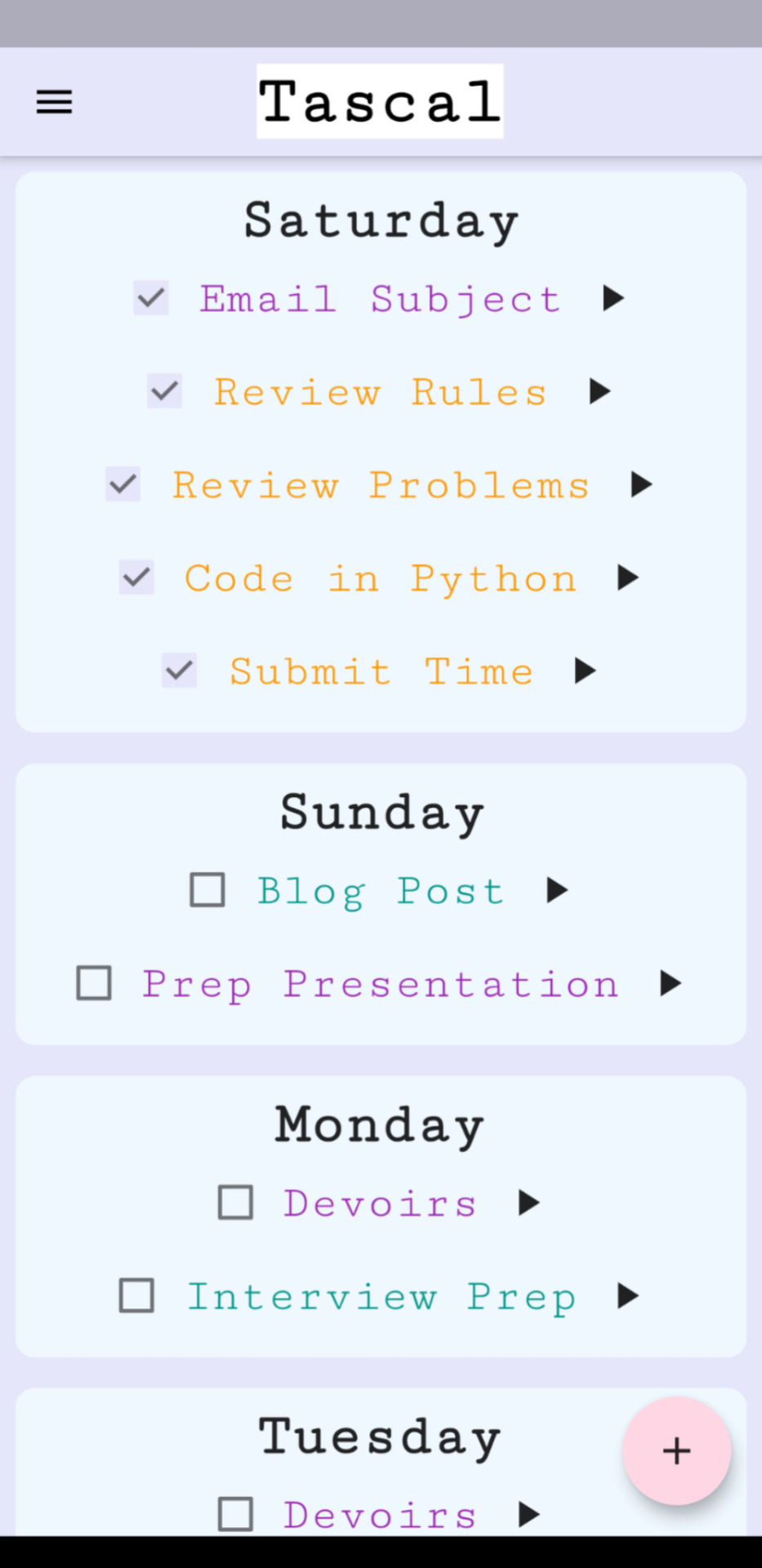
In terms of code, there are 13 Dart files, including five screen files, one for each view, one for adding new tasks, and another for adding new projects. There are also five component files including the task and project objects and screen components such as the scaffold, the add button, and the reusable card (used for projects and days of the week). The final three files are the main file, a file of constants, and a file of app data.
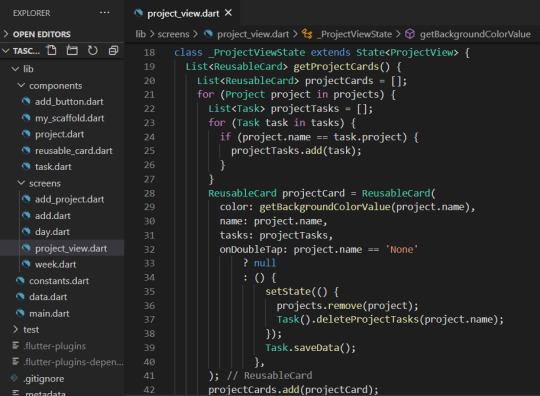
Coding Tascal took 28 hours over the course of eight days. While it was a lot of fun and a great learning experience, the coolest part is getting to use it on a daily basis. To learn more about my college organization systems and old task management systems, click here. You can also read about the technology and apps I use in college. While I love and am very proud of Tascal, it’s definitely not perfect and has plenty of room for improvement.
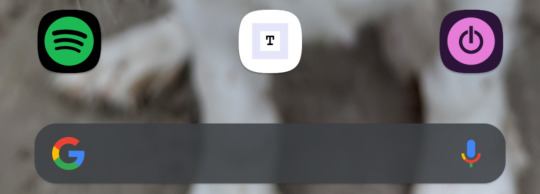
Bugs to Fix and Areas for Improvement:
Check the day more frequently
While you don’t have to tell the app that it’s a new day, you have to tell it to check by reloading (exiting and returning to) the today view
Make the today view adaptive to the screen
The today view currently has a set width which means it doesn’t adapt well to landscape view
Set a character limit to task names
If the title of a task is too long, the screen shows yellow and black stripes where there is text-overflow
Add the ability to easily reorder tasks
Currently, new tasks and tasks that have been checked off (or unchecked) are added/moved to the bottom of the list
Allow tasks to repeat multiple days a week
For instance, Monday, Wednesday, and Friday
Allow tasks to repeat after a set number of days
For instance, every third day or every two weeks
Allow for subtasks
Add a simple notes screen
This is a feature that I miss from the web version. I did it there because I had a two-row week layout for an odd number of days.
Add user accounts and the ability to access data across devices
Currently, the app just stores data locally on my phone
Upload Tascal to the Apple App Store and Google Play Store
As it is now, the code was directly uploaded from my laptop to my phone through a wired connection
#college#Smith College#app development#Tascal#flutter#London app brewery#task management#organization#computer science#programming#independent learning
1 note
·
View note
Photo
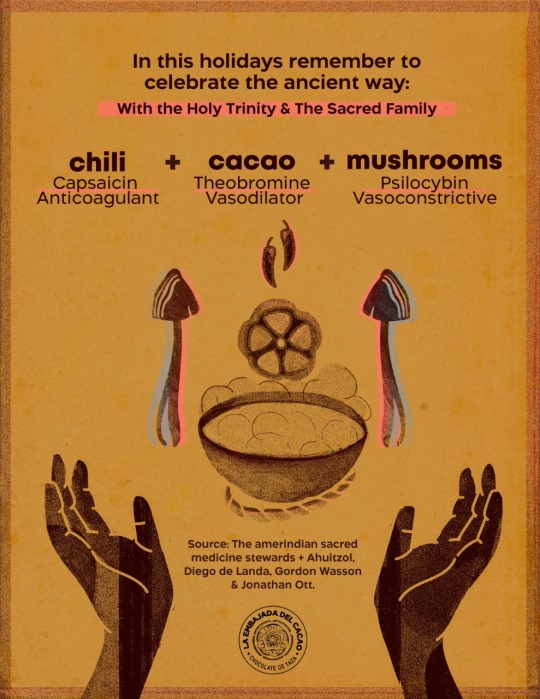
..::A living ethnobotanical tribute to the memory of Valentina Pavlovna Wasson::..
¨ They gave us chocolate to drink, somewhat ceremonially, and suddenly I recalled the words of the early Spanish writer who had said that before the mushrooms were served, chocolate was drunk. I sensed what we were in for: at long last we were discovering that the ancient communion rite still survived and we were going to witness it. The mushrooms lay there in their box, regarded by everyone respectfully but without solemnity.¨ Gordon Wasson
May the women, the Goddess & sacred femenine rise up again .
Artwork and graphic desing:
Life Magazine May 13, 1957. Great Adventures III - The Discovery of Mushrooms That Cause Strange Visions. Secrets of "Divine Mushrooms".
#decolonizeyourmind#ethnobotany#psychonautics#ethnopharmacology#herbalism#metashamanism#fitotherapy#sacredplantmedicine#vegetablequeendom#Yoyotlleztli#ixkakaw#ixbalam#xocolata#ceremonialcacao#anahuac#atlachinolli#pozol#bupu#chilate#tascalate#xocoatl#chorote#chucula#totuma#jicara#cuyabro#recolonizeyourgut
15 notes
·
View notes
Text



Pretty food for today.
Mexican seasonal dish “Chile en Nogada” and “Tascalate” prehispanic beverage made with corn, cocoa beans, nibs, ground cinammon and achiote.
Also a beet salad with citrus infused vinaigrette.
3 notes
·
View notes
Text
Pedro Tascal

Pls give credits if you repost <3
“Pocket pedro”
6 notes
·
View notes
Text
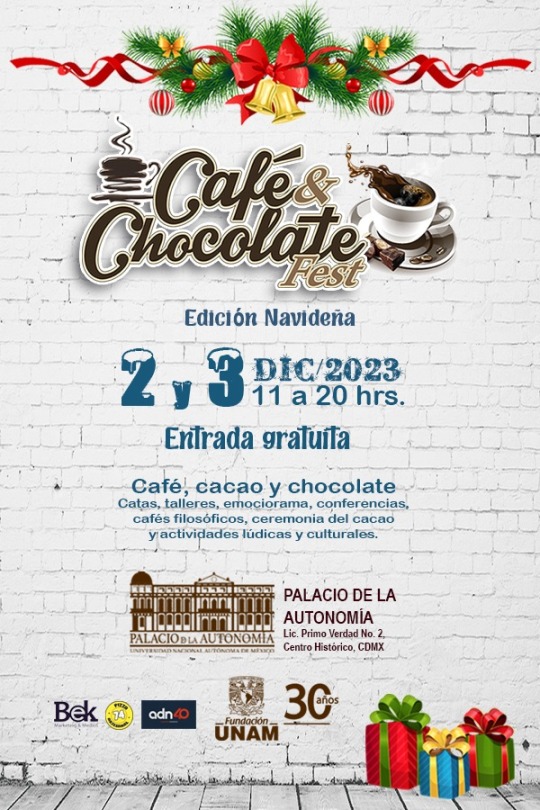
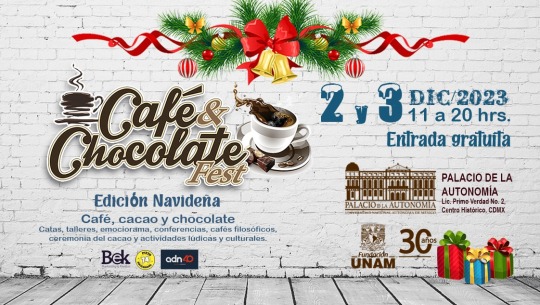

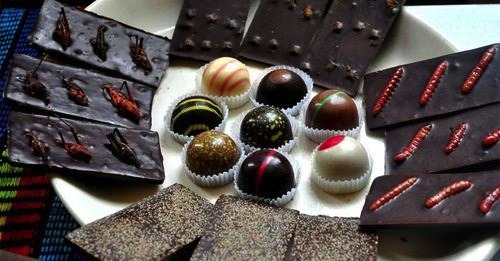
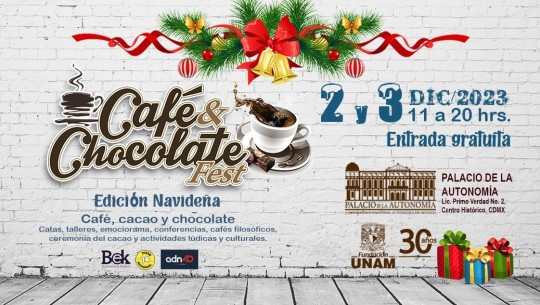
CAFÉ Y CHOCOLATE FEST anuncia EDICIÓN NAVIDEÑA en el PALACIO DE LA AUTONOMÍA DE LA FUNDACIÓN UNAM, los días 2 Y 3 DE DICIEMBRE, 2023.
Participan más de 60 EXPOSITORES con deliciosos productos artesanales de diversas regiones del país.
LA ENTRADA ES LIBRE y el evento incluye ACTIVIDADES CULTURALES Y LÚDICAS completamente gratis.
Comienza temporada de frío y que mejor que tomar un café o un chocolate calientito.
La buena noticia es que ya viene el CAFÉ Y CHOCOLATE FEST - EDICIÓN NAVIDEÑA,
donde el público podrá conseguir chocolate con alto porcentaje de cacao y el mejor café directo de productores mexicanos que vienen desde Chiapas, Veracruz, Tabasco, Oaxaca, Puebla, Tlaxcala y Estado de México, entre otros estados de la República Mexicana.
Este es el evento ideal para surtirse de café molido, en grano, con diferentes tuestes y categorías. Por supuesto, no pueden faltar las bebidas que se podrán degustar ahí como café late, capuchinos, café de olla, café turco, chocolate espumoso y las tradicionales como el tascalate, chilate, agua de barranca y pozol, además de un gran surtido de tés.
Para los amantes del chocolate es como llegar al paraíso porque habrá miles de chocolates en varias modalidades. Desde la tableta para preparar el chocolate con leche o con agua, barras con chipotle y ajonjolí, con arándanos, taro, chapulines y gusanos de maguey, hasta deliciosas trufas y bombonería de chocolate con rellenos deliciosos y combinaciones exóticas como romero y te verde, naranja con whisky, frutos rojos, queso azul, maracuyá, queso con frambuesa y un largo etcétera. También podrán encontrar deliciosa moka y chocolate untable para rellenar sus pasteles, utilizar en postres ó simplemente para untar en una rebanada de pan.
Esta EDICIÓN NAVIDEÑA tan especial, llega con grandes atractivos como galletas, chocolates, gomitas, panqués y bombonería decorados con motivos de esta bella temporada, ideales para un regalito o para tener en casa y compartir en familia o con nuestros invitados.
El CAFÉ Y CHOCOLATE FEST se ha distinguido por su interesante Programa de Actividades Culturales y Lúdicas con Música en vivo, Catas de Contraste de Café, el Taller Sensorial Emociorama, Chocolatería Literaria, Conferencias y Charlas con contexto cultural sobre la importancia de la semilla de cacao y el grano del café en la alimentación y en actividades de comercio que acostumbraban nuestros antepasados, quienes inclusive utilizaban estos productos como moneda de cambio y también en celebraciones y rituales, por lo que la tradición de las Ceremonias de Cacao estará presente.
Este es un EVENTO GRATUITO y todas las actividades antes mencionadas también son sin costo. La gente que asista solo gastará en las compras que desee hacer de lo que más se le antoje de la vasta oferta de productos de la mano de más de 60 EXPOSITORES.
Un porcentaje de lo que se recaude por la venta de productos será destinado al fondo para el Programa de Becas de la Fundación UNAM.
El CAFÉ Y CHOCOLATE FEST – EDICIÓN NAVIDEÑA está diseñado para pasar gran parte del día en él, por lo que se ha adaptado un Área de Alimentos Preparados para que los asistentes puedan almorzar o comer ahí; todo muy rico, con mucha higiene y muy bien organizado.
Las actividades están programadas en horarios desde que inicia el evento a las 11 AM, hasta el cierre a las 8 PM. La recomendación es que al llegar, se inscriban en la actividad que más les atraiga, ya que son con cupo limitado.
El Café y Chocolate Fest- Edición Navideña se llevará a cabo el Sábado 2 y Domingo 3 de Diciembre en el Palacio de la Autonomía de la Fundación UNAM en el Centro Histórico de la CDMX, calle Lic. Primo de Verdad No. 2 casi esq. con Moneda, justo a dos cuadras de la plancha del Zócalo.
En esta temporada y siendo un evento familiar, no puede faltar Santa Claus, quien visitará la expo para que los niños le entreguen sus cartas y todos los que gusten se puedan tomar la foto.
CAFÉ & CHOCOLATE FEST- EDICIÓN NAVIDEÑA
SÁBADO 2 Y DOMINGO 3 DE DICIEMBRE, 2023.
11 A 20 H.
PALACIO DE LA AUTONOMÍA DE LA FUNDACIÓN UNAM.
Calle Lic. Primo De Verdad No. 2 esq. con Moneda, C.P. 06060, Centro Histórico, CDMX.
-50 Expositores
-Catas, Talleres Sensoriales, Conferencias, Charlas, Chocolaterías literarias, Ceremonias de Cacao, Alimentos preparados, Santa Claus y Música en vivo.
Evento Familiar.
ENTRADA Y ACTIVIDADES CULTURALES SIN COSTO https://www.facebook.com/cafeychocolatefest/ www.facebook.com/fundacion.unam.mx www.fundacionunam.org.mx
@cafeychocolatefest_
@Fundación_UNAM
@Museo_Autonomía
#zerounotv#mexico#CAFÉ Y CHOCOLATE FEST anuncia EDICIÓN NAVIDEÑA en el PALACIO DE LA AUTONOMÍA DE LA FUNDACIÓN UNAM#los días 2 Y 3 DE DICIEMBRE#Participan más de 60 EXPOSITORES con deliciosos productos artesanales de diversas regiones del país.#LA ENTRADA ES LIBRE y el evento incluye ACTIVIDADES CULTURALES Y LÚDICAS completamente gratis.#Comienza temporada de frío y que mejor que tomar un café o un chocolate calientito.#La buena noticia es que ya viene el CAFÉ Y CHOCOLATE FEST - EDICIÓN NAVIDEÑA
1 note
·
View note
Photo

"A Very Excited Boi" https://www.reddit.com/r/aww/comments/a5uj4o/a_very_excited_boi/?utm_source=ifttt
0 notes
Photo









I get a little bit overwhelmed but I find you when I need you most. You are the compass that I’ve always held. And with you I can be myself.
0 notes
Text
How I Use Microsoft To Do as a Student
Many aspects of my academic organization system have remained constant since or before high school. Namely, Microsoft OneNote for notes, Google Calendar for events, Google Drive for files, and Toggl Track for time tracking. For a deep dive into how I use OneNote as a student, click here. As for task management, I've found myself continually trying and creating new systems. Despite always feeling the need to optimize my system, task management hasn’t actually been an issue for me. This post primarily serves as an update style post in regard to my task management journey. That said, I also hope you find some useful tips and tricks as well.
My current task management tool of choice is Microsoft To Do. Before diving into my current system here’s a brief summary of my prior tools and systems. In high school, I tried a paper planner, bullet journaling, Asana, and Google Keep. During my first semester of college, I used a two-part system consisting of Google Keep for school tasks and Google Tasks for personal ones. During the spring of my first year, I simplified things to using a single application. Specifically, I added my tasks to the description section of a Google Calendar event. The main issue with that system was that it lacked satisfying checkboxes to check off and proper color coding. During the summer before my sophomore year, I designed and built my very own Android to-do list app called Tascal. Tascal served me well for the entirety of my sophomore year but wasn’t ideal for projects or long-term planning. The other key limitation was that I could only access my task list from my phone.
I started using the web version of To Do last summer while interning at Microsoft, which you can read about here. I also vaguely recall trying it out a few years ago, but don’t remember the specifics. Like OneNote, To Do is free, has great cross-platform support, and simply requires a Microsoft account. I primarily use the Android and Windows applications on my phone and laptop respectively but also have the iPad app.
Within To Do I divide my tasks into school, work, and personal. (In actuality the personal list also includes all of my miscellaneous tasks). School tasks are further divided into separate lists for each class. In addition to a name, each list has an emoji and a color theme. The emojis are mostly to add a pop of color (that corresponds to the color coding in my other organization tools). Ideally, I would have relevant emojis for each list, but unfortunately, there isn’t a good emoji for each class that also fits my color-coding. Additionally, while there is a pink brain emoji that would be perfect for my cognitive science class, for some reason, To Do doesn’t support it replacing the default icon. I’ve also done my best to match each list's background color (theme) to the respective class, but unfortunately To Do is somewhat limited when it comes to color choices. I use the default list as an inbox of sorts for when I add tasks and don’t have the time to fully flesh out the relevant details. (Last semester I used the default list for all of my personal tasks but have preferred the dedicated personal task list).
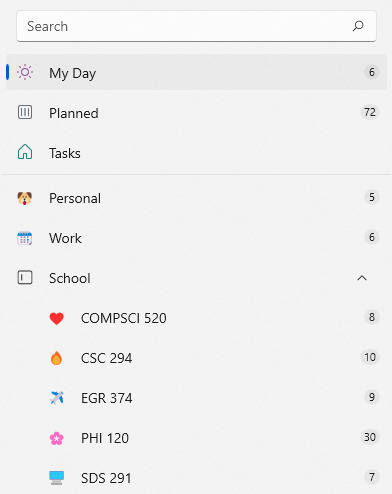
To plan out my tasks for the day, I use the My Day list which displays tasks for the current day. To Do automatically suggests tasks that are due soon and those that have been recently added. My Day resets at the end of each day which forces you to plan your day with more intentionality. While I like this feature, I wish it allowed me to plan out my tasks the night before.
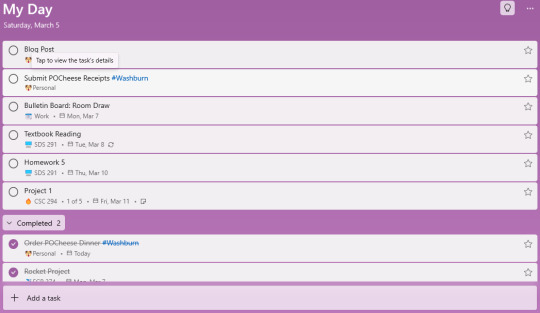
As for getting tasks into To Do, it’s as simple as adding a name and pressing enter. The real magic happens when you add all of your assignments (from the syllabus) at the start of the semester.
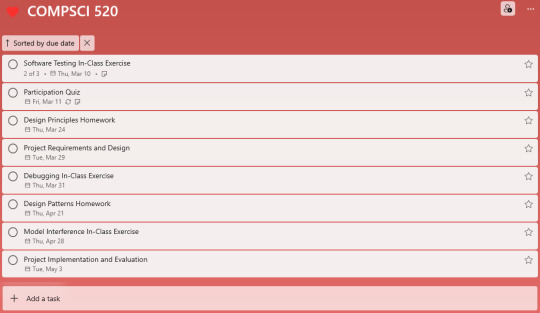
For basic recurring tasks (like this weekly blog post), I use the repeat feature so that To Do automatically generates future instances for me. I also use this feature for pre-class textbook readings and other informal recurring assignments. For weekly problem sets, I manually add each (with a corresponding number) so that it shows up in the planned view. (In contrast, for repeating tasks, only the next occurrence shows up in the various lists). Obviously I still sometimes need to add new tasks, but for the most part, all of my assignments for the semester are already captured.

I used to dislike due date-focused task management systems because they don’t always clearly convey the day in which you’d like to get a task done. However, what I’ve come to understand is that due dates make my task management system a much better planning tool capable of replacing some of the core functionality of a calendar. That said, one missing feature from To Do is a graphical calendar view.
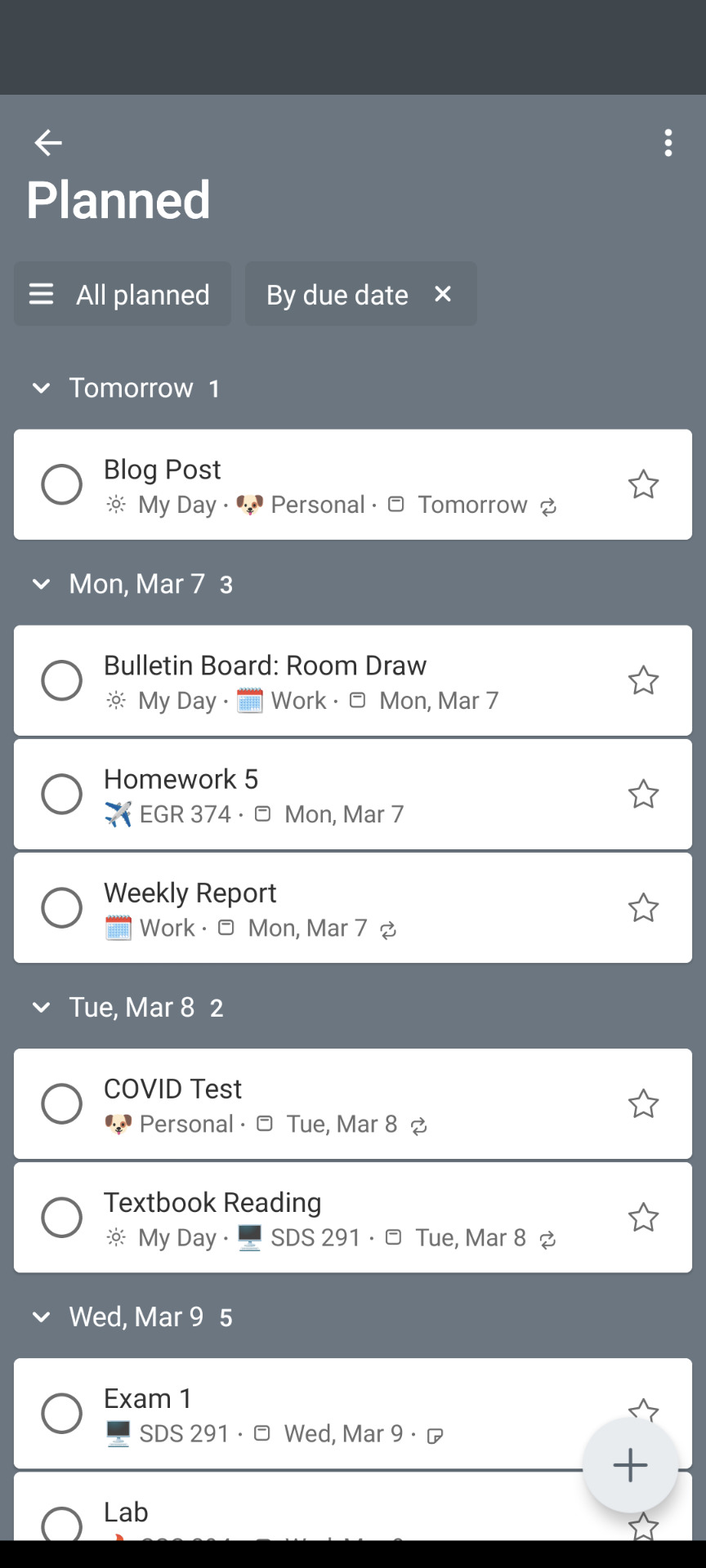
In addition to a task name and due date, To Do allows you to optionally add a reminder, subtasks, and/or a description. I find the description section particularly useful for either linking to the assignment itself or including some quick relevant notes. Even though I rarely create subtasks (or steps as To Do calls them), this is a pretty standard feature that I’ve come to expect. I only really use the reminder feature for my work tasks as action is often required well in advance of a stated deadline.
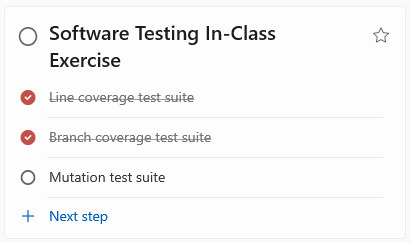
To Do also allows you to link actual files to your tasks and tag tasks with the pound symbol. It isn’t a full-fledged tagging system, but when clicked on, the tags launch a search. To Do can also be used by teams as it supports sharing lists and assigning tasks to other To Do users. Additionally, Outlook users (of which I am not) can have flagged emails automatically turned into tasks.
5 notes
·
View notes
Text








Food of Oaxaca:
Chocolate con agua
"Meat Alley” in Mercado 20 de Noviembre. Choose your meats, then your veggies/salsas, tortillas and a drink.
Tlayuda stand. A crunchy quesadilla-like goodie.
Tejate: cacao, maiz, ground mamey pits, and cacao blossoms.
Atole blanco: masa beverage.
Tascalate: maíz, cacao, pine nuts, anchiote, vanilla, sugar.
Champurrado: atole with cacao.
0 notes
Text
Cerca, Chiapas

El Pueblo Mágico es un paraíso para los amantes de una arqueología, la relato y la natural. Primero, es vecino al sitio arqueológico de Palenque; y segundo, es un espacio privilegiado para explorar la selva, descubrir cascadas o deleitarse con los angeles vista de lagunas y la fauna de la comarca. Tal es los angeles importancia del web arqueológico de Empalizada que forma zona del Patrimonio de la Humanidad de la UNESCO desde 1987.
Palenque fue constituido Ocozocoautla en linea por fray Pedro Lorenzo, a cierta distancia de las ruinas del exacto nombre en 1567. El padre dominico integró el nación con muchas familias choles dispersas en la Selva Lacandona. Se sabe que los nativos llamaban a Palenque, Tulum palabra de causa chol que cuenta "Sitio cercado u fortificado".
Características:
Sobre castellano, Palenque cuenta “lugar cercado de una valla de madera o estacas”. La ciudad prehispánica data del siglo III, fue la de las ciudades más notables delete mundo maya; ademas actuó como asociacion ceremonial, gracias a los patronos mayas interesados en ense?ar su poder. Fue una de las ciudades mayas muy importantes de tu tiempo, i smag med par de Calakmul y de Tikal. Una población actual está compuesta por pueblos originarios como chol, tzeltal y lacandón.
Palenque se localiza en el corazón de sureste de México, al noreste del estado de Chiapas, en una área de selva exotic alta donde abundan cascadas y ríos. Su clima sera tropical, cálido, húmedo y lluvioso; que tiene temperatura media de 27º C y picos de 36º C.
Sobre ela gastronomía local predomina el sabor autóctono, tais como los tamales chiapanecos, el pato en chirmol, el pez sudado o el salpicón de ciervo. Para beber ze sugiere probar el tascalate, el pozol o la v; y como postre, prueba los dulces elaborados basics de miel de abeja.
Entre las artesanías de la zona destacan prendas exquisitamente bordadas, cerámica y joyería trabajada en ámbar.
1 note
·
View note
